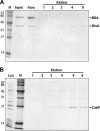Cyclic di-AMP impairs potassium uptake mediated by a cyclic di-AMP binding protein in Streptococcus pneumoniae
- PMID: 24272783
- PMCID: PMC3911161
- DOI: 10.1128/JB.01041-13
Cyclic di-AMP impairs potassium uptake mediated by a cyclic di-AMP binding protein in Streptococcus pneumoniae
Abstract
Cyclic di-AMP (c-di-AMP) has been shown to play important roles as a second messenger in bacterial physiology and infections. However, understanding of how the signal is transduced is still limited. Previously, we have characterized a diadenylate cyclase and two c-di-AMP phosphodiesterases in Streptococcus pneumoniae, a Gram-positive pathogen. In this study, we identified a c-di-AMP binding protein (CabP) in S. pneumoniae using c-di-AMP affinity chromatography. We demonstrated that CabP specifically bound c-di-AMP and that this interaction could not be interrupted by competition with other nucleotides, including ATP, cAMP, AMP, phosphoadenylyl adenosine (pApA), and cyclic di-GMP (c-di-GMP). By using a bacterial two-hybrid system and genetic mutagenesis, we showed that CabP directly interacted with a potassium transporter (SPD_0076) and that both proteins were required for pneumococcal growth in media with low concentrations of potassium. Interestingly, the interaction between CabP and SPD_0076 and the efficiency of potassium uptake were impaired by elevated c-di-AMP in pneumococci. These results establish a direct c-di-AMP-mediated signaling pathway that regulates pneumococcal potassium uptake.
Figures







Similar articles
-
Bacterial Second Messenger Cyclic di-AMP Modulates the Competence State in Streptococcus pneumoniae.J Bacteriol. 2020 Jan 29;202(4):e00691-19. doi: 10.1128/JB.00691-19. Print 2020 Jan 29. J Bacteriol. 2020. PMID: 31767779 Free PMC article.
-
Stress Suppressor Screening Leads to Detection of Regulation of Cyclic di-AMP Homeostasis by a Trk Family Effector Protein in Streptococcus pneumoniae.J Bacteriol. 2018 May 24;200(12):e00045-18. doi: 10.1128/JB.00045-18. Print 2018 Jun 15. J Bacteriol. 2018. PMID: 29483167 Free PMC article.
-
Two DHH subfamily 1 proteins in Streptococcus pneumoniae possess cyclic di-AMP phosphodiesterase activity and affect bacterial growth and virulence.J Bacteriol. 2013 Nov;195(22):5123-32. doi: 10.1128/JB.00769-13. Epub 2013 Sep 6. J Bacteriol. 2013. PMID: 24013631 Free PMC article.
-
Replenishing the cyclic-di-AMP pool: regulation of diadenylate cyclase activity in bacteria.Curr Genet. 2016 Nov;62(4):731-738. doi: 10.1007/s00294-016-0600-8. Epub 2016 Apr 13. Curr Genet. 2016. PMID: 27074767 Review.
-
A jack of all trades: the multiple roles of the unique essential second messenger cyclic di-AMP.Mol Microbiol. 2015 Jul;97(2):189-204. doi: 10.1111/mmi.13026. Epub 2015 May 9. Mol Microbiol. 2015. PMID: 25869574 Review.
Cited by
-
Bacterial Second Messenger Cyclic di-AMP Modulates the Competence State in Streptococcus pneumoniae.J Bacteriol. 2020 Jan 29;202(4):e00691-19. doi: 10.1128/JB.00691-19. Print 2020 Jan 29. J Bacteriol. 2020. PMID: 31767779 Free PMC article.
-
Cyclic di-adenosine monophosphate (c-di-AMP) is required for osmotic regulation in Staphylococcus aureus but dispensable for viability in anaerobic conditions.J Biol Chem. 2018 Mar 2;293(9):3180-3200. doi: 10.1074/jbc.M117.818716. Epub 2018 Jan 11. J Biol Chem. 2018. PMID: 29326168 Free PMC article.
-
Identification, characterization, and structure analysis of the cyclic di-AMP-binding PII-like signal transduction protein DarA.J Biol Chem. 2015 Jan 30;290(5):3069-80. doi: 10.1074/jbc.M114.619619. Epub 2014 Nov 28. J Biol Chem. 2015. PMID: 25433025 Free PMC article.
-
Structural Studies of Potassium Transport Protein KtrA Regulator of Conductance of K+ (RCK) C Domain in Complex with Cyclic Diadenosine Monophosphate (c-di-AMP).J Biol Chem. 2015 Jun 26;290(26):16393-402. doi: 10.1074/jbc.M115.641340. Epub 2015 May 7. J Biol Chem. 2015. PMID: 25957408 Free PMC article.
-
DhhP, a cyclic di-AMP phosphodiesterase of Borrelia burgdorferi, is essential for cell growth and virulence.Infect Immun. 2014 May;82(5):1840-9. doi: 10.1128/IAI.00030-14. Epub 2014 Feb 24. Infect Immun. 2014. PMID: 24566626 Free PMC article.
References
Publication types
MeSH terms
Substances
Grants and funding
LinkOut - more resources
Full Text Sources
Other Literature Sources
Molecular Biology Databases
Research Materials

